Development of a New Ultra-High-Precision Magnetic Abrasive Finishing for Wire Material Using a Rotating Magnetic Field
Abstract
:1. Introduction
- It requires very expensive equipment.
- It can cause damage in the substrate.
- It uses strong toxic gas sources (i.e., phosphine, and arsine).
- It has higher impurity content than diffusion.
- Difficult to achieve very deep and very shallow profiles.
2. Experimental Methods
3. Experiment of Ultra-High-Precision Magnetic Abrasive Finishing
3.1. Design of Rotating Magnetic Field
3.2. Experimental Setup
3.3. Material and Experimental Conditions
4. Results and Discussions
4.1. Effect of Rotational Speed of Rotating Magnetic Field on Finishing Process
4.2. Effect of Unbonded Magnetic Abrasive Grain Size on Finishing Process
4.3. Effect of Wire Workpiece Vibration Frequency on Finishing Process
5. Conclusions
- The study revealed that a new development of ultra-high-precision magnetic abrasive finishing for wire material using a rotating magnetic field was successfully performed. This process could be used for improving the surface roughness and the removed diameter of wire material instead of some advanced surface treatment methods such as plasma coating, and ion implantation.
- This new ultra-high-precision magnetic abrasive finishing has several advantages over the conventional finishing processes. These advantages are that it has the capability for producing a smooth surface finish and removing a diameter of wire material, while the other finishing processes cannot achieve this.
- The highest rotational speed used in this study, which is 800 rpm, shows a significant effect on the improvement of surface roughness and removed diameter of wire material. This can be explained due to the high centrifugal forces generated by the highest rotational speed at 800 rpm.
- The highest improvement of surface roughness and removed diameter is observed when 0.5 μm of magnetic abrasive grain size was used with the increasing of the wire workpiece frequency at a certain level.
- The best result is found when the wire material workpiece finished with a 0.5 μm magnetic abrasive grain size and 10 Hz of vibration frequency at 800 rpm for 60 s and the original surface roughness was enhanced from 0.25 µm to 0.02 µm.
- Despite the potential advantages of the ultra-high-precision magnetic abrasive finishing process, the one disadvantage is that this finishing process can remove the diameter of the wire workpiece only in terms of the micro-scale removal.
- Current and future works are focused on the development of a new method for application to ultra-high-precision finishing of AISI 1085 steel wire material. According to the result, this method has significant potential for achieving a good surface finish and a removed diameter with wire material such as AISI 1085 steel wire with the size of 0.6 mm in diameter. In our future work, this method will apply to ultra-high-precision finishing of the biomaterials with a diameter smaller than 0.6 mm (i.e., nickel titanium wire, 316L stainless steel wire, and titanium molybdenum alloy arch wire).
Author Contributions
Funding
Acknowledgments
Conflicts of Interest
References
- Gbur, J.L.; Lewandowski, J.J. Fatigue and fracture of wires and cables for biomedical applications. Int. Mater. Rev. 2016, 61, 231–314. [Google Scholar] [CrossRef]
- Duering, T.W.; Pelton, A.; Stockel, D. An overview of nitinol medical applications. Mater. Scien. Eng. A. 1999, 273, 149–160. [Google Scholar] [CrossRef]
- Andreasen, G.F.; Hilleman, T.B. An evaluation of 55 cobalt substituted Nitinol wire for use in orthodontics. J. Am. Dent. Assoc. 1971, 82, 1373–1375. [Google Scholar] [CrossRef] [PubMed]
- Haga, Y.; Mineta, T.; Totsu, K.; Makishi, W.; Esashi, M. Development of active catheter, active guide wire and micro sensor systems. Interv. Neuroradiol. 2001, 7, 125–130. [Google Scholar] [CrossRef] [PubMed]
- Haga, Y.; Esashi, M. Small diameter active catheter using shape memory alloy coils. IEEJ Trans. Sens. Micromach. 2000, 120, 509–514. [Google Scholar] [CrossRef]
- Jacob, L.; Geenen, J.E. ERCP guide wires. Gastrointest. Endosc. 1996, 43, 57–60. [Google Scholar] [CrossRef]
- Freeman, M.L.; Guda, N.M. ERCP cannulation: A review of reported techniques. Gastrointest. Endosc. 2005, 61, 112–125. [Google Scholar] [CrossRef]
- Wong, J.; House, R. Pacemaker twist: Twiddler’s syndrome. Australas. Radiol. 1993, 37, 286–287. [Google Scholar] [CrossRef]
- Al Sabti, H.; Menon, R.G.; Maddali, M.M.; Valliattu, J. Wandering permanent pacemaker generators in children: A case series. J. Med. Case Rep. 2008, 2, 163. [Google Scholar] [CrossRef]
- Krishnan, M.; Saraswathy, S.; Sukumaran, K.; Abraham, K.M. Effect of ion-implantation on surface characteristics of nickel titanium and titanium molybdenum alloy arch wires. Indian J. Dent. Res. 2013, 24, 411–417. [Google Scholar] [CrossRef]
- Denstedt, J.D.; Wollin, T.A.; Reid, G. Biomaterials used in urology: Current issues of biocompatibility, infection, and encrustation. J. Endourol. 1998, 12, 493–500. [Google Scholar] [CrossRef] [PubMed]
- Kumar, H.; Singh, S.; Nanak, G.; Kumar, P. Magnetic abrasive finishing-A review. Int. J. Eng. Res. Technol. 2013, 2, 1–8. [Google Scholar]
- Le, X.; Peterson, M. Material removal rate in flat lapping. J. Manuf. Process. 1999, 1, 71–78. [Google Scholar] [CrossRef]
- Jha, S.K. Optimization of process parameters for optimal MRR during turning steel bar using taguchi method and ANOVA. Int. J. Mech. Eng. Robot. Res. 2014, 3, 231–243. [Google Scholar]
- Jiao, A.Y.; Quan, H.J.; Li, Z.Z.; Chen, Y. Study of magnetic abrasive finishing in seal ring groove surface operations. Int. J. Adv. Manuf. Technol. 2016, 85, 1195–1205. [Google Scholar] [CrossRef]
- Sequera, A.; Fu, C.H.; Guo, Y.B.; Wei, X.T. Surface integrity of inconel 718 by ball burnishing. J. Mater. Eng. Perform. 2014, 23, 3347–3353. [Google Scholar] [CrossRef]
- Malik, V.P.; Khomaza, Y.M.; Serichenko, V.I. Investigation of the efficiency of diamond honing stones in super finishing carbon steels. Chem. Pet. Eng. 1972, 8, 540–542. [Google Scholar] [CrossRef]
- Fritz Klocke, E.h.; Kuchie, A. Honing. In Manufacturing Processes 2: Grinding, Honing, Lapping; Springer: Berlin/Heidelberg, Germany, 2009; pp. 1–36. [Google Scholar]
- Belyaev, G.S. Cutting ability of abrasive grains in lapping in titanium sealing surfaces. Chem. Pet. Eng. 1979, 15, 293–294. [Google Scholar] [CrossRef]
- Heng, L.; Jig Kim, Y.; Don Mun, S. Review of superfinishing by the magnetic abrasive finishing process. High Speed Mach. 2017, 3, 42–55. [Google Scholar] [CrossRef]
- Jun Park, N.; Heng, L.; Wang, R.; Kim, M.; Don Mun, S. Ultra-high-precision machining of microscale-diameter zirconia ceramic bars by means of magnetic abrasive finishing. Appl. Mech. Mater. 2016, 851, 98–105. [Google Scholar] [CrossRef]
- Deepark, B.; Walia, R.; Suri, N. Effect of Rotational Motion on the Flat Work Piece Magnetic Abrasive Finishing. Int. J. Surf. Eng. Mater. Technol. 2012, 2, 50–54. [Google Scholar]
- Rampal, R. Comparing the magnetic abrasives by investigating the surface finish. J. Eng. Comput. Appl. Sci. 2012, 1, 20–24. [Google Scholar]
- Luo, X.; Cheng, K.; Webb, D.; Wardle, F. Design of ultraprecision machine tools with applications to manufacture of miniature and micro components. J. Mater. Process. Technol. 2005, 167, 515–528. [Google Scholar] [CrossRef] [Green Version]
- Al Jabbari, Y.; Fehrman, J.; Barnes, A.C.; Zapf, A.M.; Zinelis, S.; Berzins, D.W. Titanium nitride and nitrogen ion implanted coated dental materials. Coatings 2012, 2, 160–178. [Google Scholar] [CrossRef]
- D’Antò, V.; Rongo, R.; Ametrano, G.; Spagnuolo, G.; Manzo, P.; Martina, R.; Paduano, S.; Valletta, R. Evaluation of surface roughness of orthodontic wires by means of atomic force microscopy. Angle Orthod. 2012, 82, 922–928. [Google Scholar] [CrossRef] [PubMed] [Green Version]
- Burstone, C.J.; Farzin-Nia, F. Production of low- friction and colored TMA by ion implantation. J. Clin. Orthod. 1995, 29, 453–461. [Google Scholar]
- Wichelhaus, A.; Geserick, M.; Hibst, R.G.; Sander, F. The effect of surface treatment and clinical use on friction in NiTi orthodontic wires. Dent. Mater. 2005, 21, 938–945. [Google Scholar] [CrossRef]
- Arango, S.; Peláez-Vargas, A.; García, C. Coating and surface treatments on orthodontic metallic materials. Coatings 2013, 3, 1–15. [Google Scholar] [CrossRef]
- Hassel, A.W. Surface treatment of NiTi for medical applications. Minim. Invasive Ther. Allied Technol. 2004, 13, 240–247. [Google Scholar] [CrossRef]
- Tan, L.; Dodd, R.A.; Crone, W.C. Corrosion and wear-corrosion behavior of NiTi modified by plasma source ion implantation. Biomaterials 2003, 24, 3931–3939. [Google Scholar] [CrossRef] [Green Version]
- Thierry, B.; Winnik, F.M.; Merhi, Y.; Silver, J.; Tabrizian, M. Radionuclides-hyaluronan-conjugate thromboresistant coatings to prevent in-stent restenosis. Biomaterials 2004, 25, 3895–3905. [Google Scholar] [CrossRef] [PubMed]
- Chowdhury, S.; Borham, J.; Catledge, S.; Eberhardt, A.W.; Johnson, P.S.; Vohra, Y.K. Synthesis and mechanical wear studies of ultra smooth nanostructured diamond (USND) coatings deposited by microwave plasma chemical vapor deposition with He/H(2)/CH(4)/N(2) mixtures. Diam. Relat. Mater. 2008, 17, 419–427. [Google Scholar] [CrossRef] [PubMed]
- Rahman, M.; Haider, J.; Hashmi, M.S.J. Health and safety issues in emerging surface engineering techniques. Compr. Mater. Process. 2014, 8, 35–47. [Google Scholar]
- Roberge, S.; Ryssel, H.; Brown, B. Safety considerations for ion implanters. Ergonomics 2000, 8, 1–35. [Google Scholar]
- Whelan, S.; Kelly, M.J.; Gwilliam, R.; Jeynes, C.; Bongiorno, C. The dependence of the radiation damage formation on the substrate implant temperature in GaN during Mg ion implantation. J. Appl. Phys. 2005, 98, 013515. [Google Scholar] [CrossRef] [Green Version]
- Vavilov, V.S. Possibilities and limitations of ion implantation in diamond, and comparison with other doping methods. Phys. Uspekhi 1994, 37, 407–411. [Google Scholar] [CrossRef]
- Djavanroodi, F. Artificial neural network modeling of surface roughness in magnetic abrasive finishing process. Eng. Technol. 2013, 6, 1976–1983. [Google Scholar] [CrossRef]
- Smolkin, M.R.; Smolkin, R.D. Calculation and analysis of the magnetic force acting on a particle in the magnetic field of separator. analysis of the equations used in the magnetic methods of separation. IEEE Trans. Magn. 2006, 42, 3682–3693. [Google Scholar] [CrossRef]
- Wang, R.; Lim, P.; Heng, L.; Don Mun, S. Magnetic abrasive machining of difficult-to-cut materials for ultra-high-speed machining of aisi 304 bars. Materials 2017, 10, 1029. [Google Scholar] [CrossRef]
- Wu, J.; Zou, Y.; Sugiyama, H. Study on finishing characteristics of magnetic abrasive finishing process using low-frequency alternating magnetic field. Int. J. Adv. Manuf. Technol. 2016, 85, 585–594. [Google Scholar] [CrossRef]
- Sun, X.; Zou, Y. Study on electrolytic magnetic abrasive finishing for finishing stainless steel SUS 304 plane with a special compound machining tool. J. Manuf. Mater. Process. 2018, 2, 41. [Google Scholar] [CrossRef]
- Mulik, R.S.; Pandey, P.M. Magnetic abrasive finishing of hardened AISI 52100 steel. Int. J. Adv. Manuf. Technol. 2011, 55, 501–515. [Google Scholar] [CrossRef]
- Wang, A.C.; Lee, S.J. Study the characteristics of magnetic finishing with gel abrasive. Int. J. Mach. Tools Manuf. 2009, 49, 1063–1069. [Google Scholar] [CrossRef]
- Chang, G.-W.; Biing Hwa, Y.; Hsu, R.-T. Study on cylindrical magnetic abrasive finishing using unbonded magnetic abrasives. Int. J. Mach. Tools Manuf. 2002, 42, 575–583. [Google Scholar] [CrossRef]


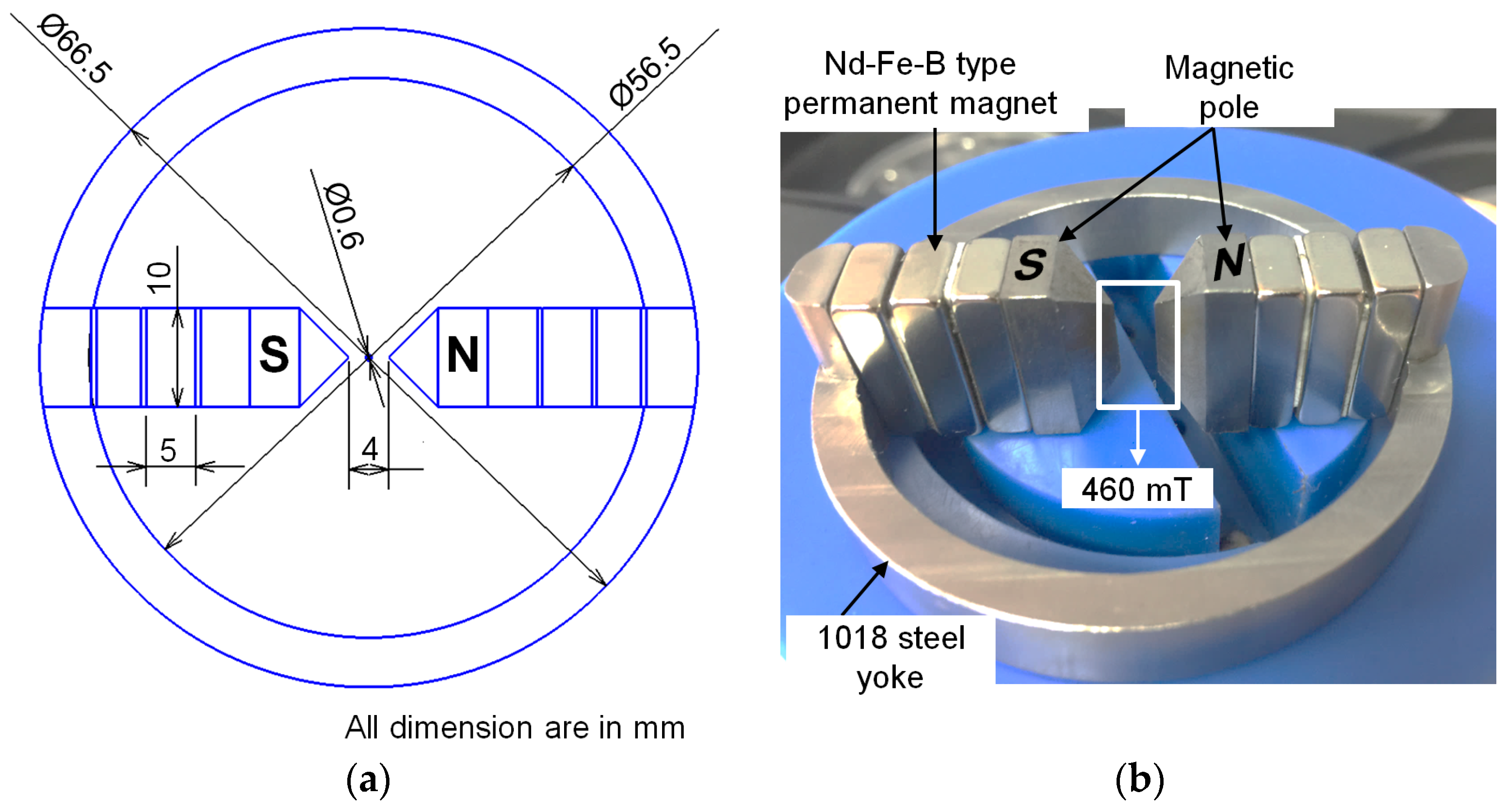
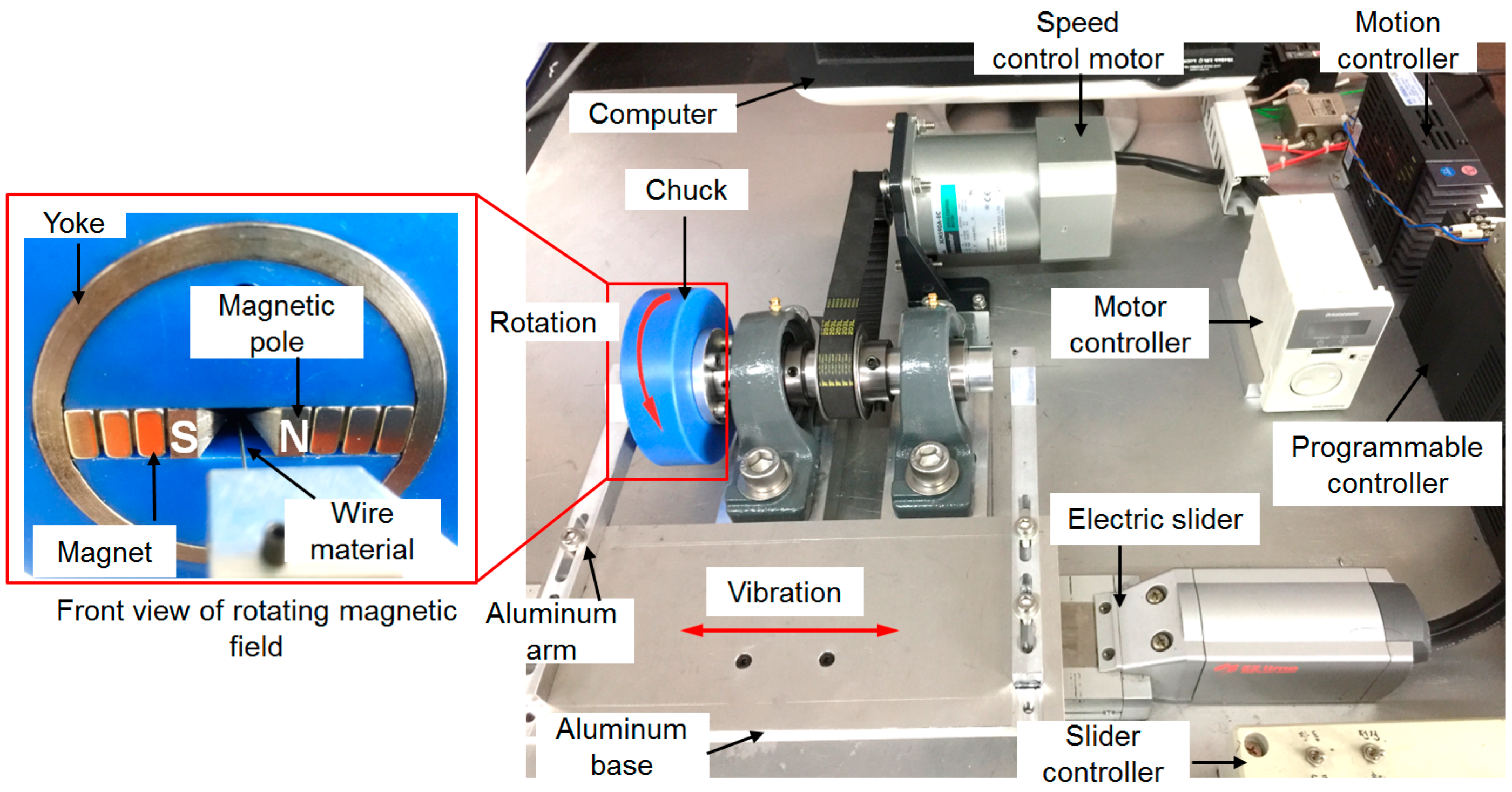

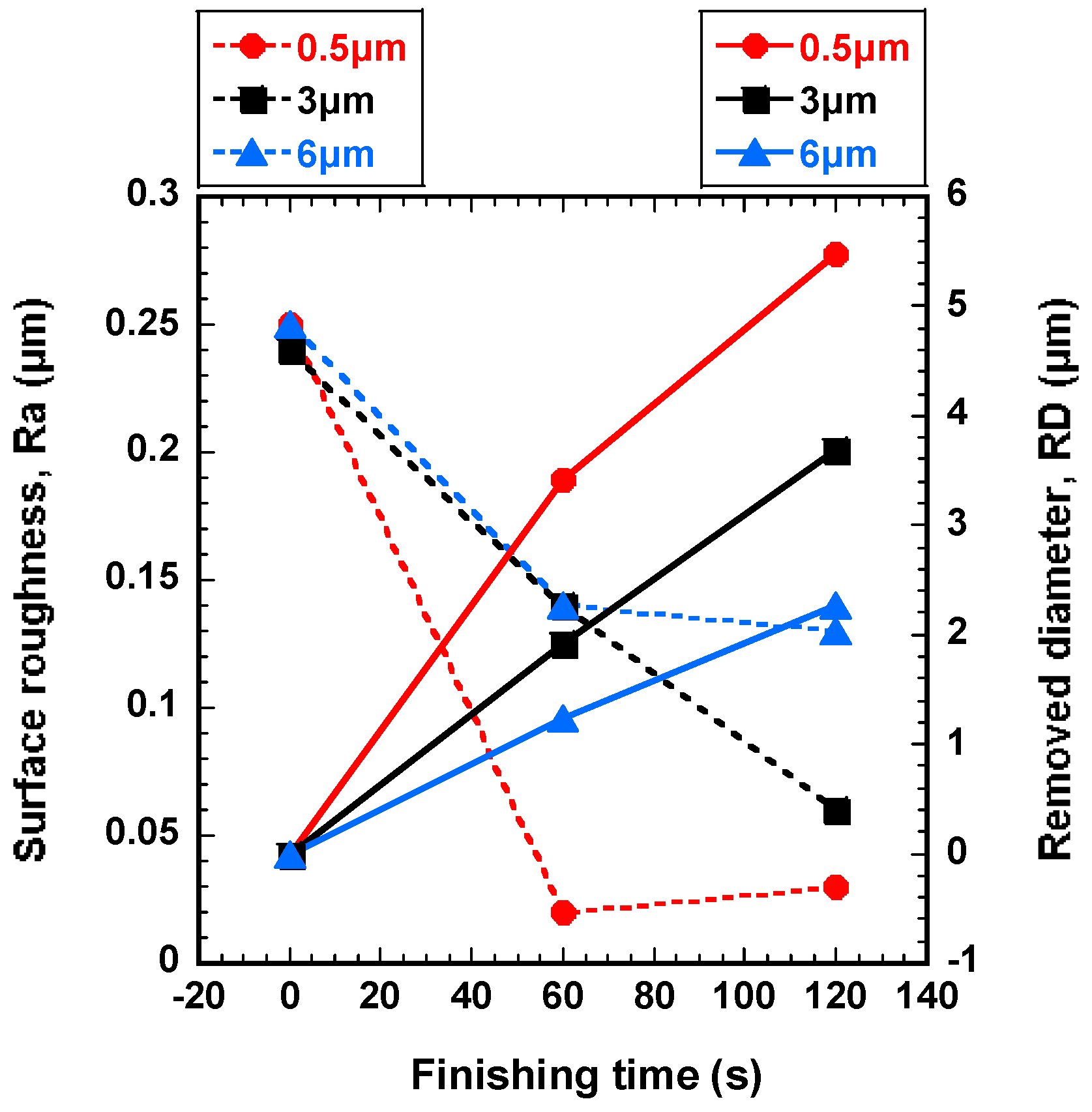
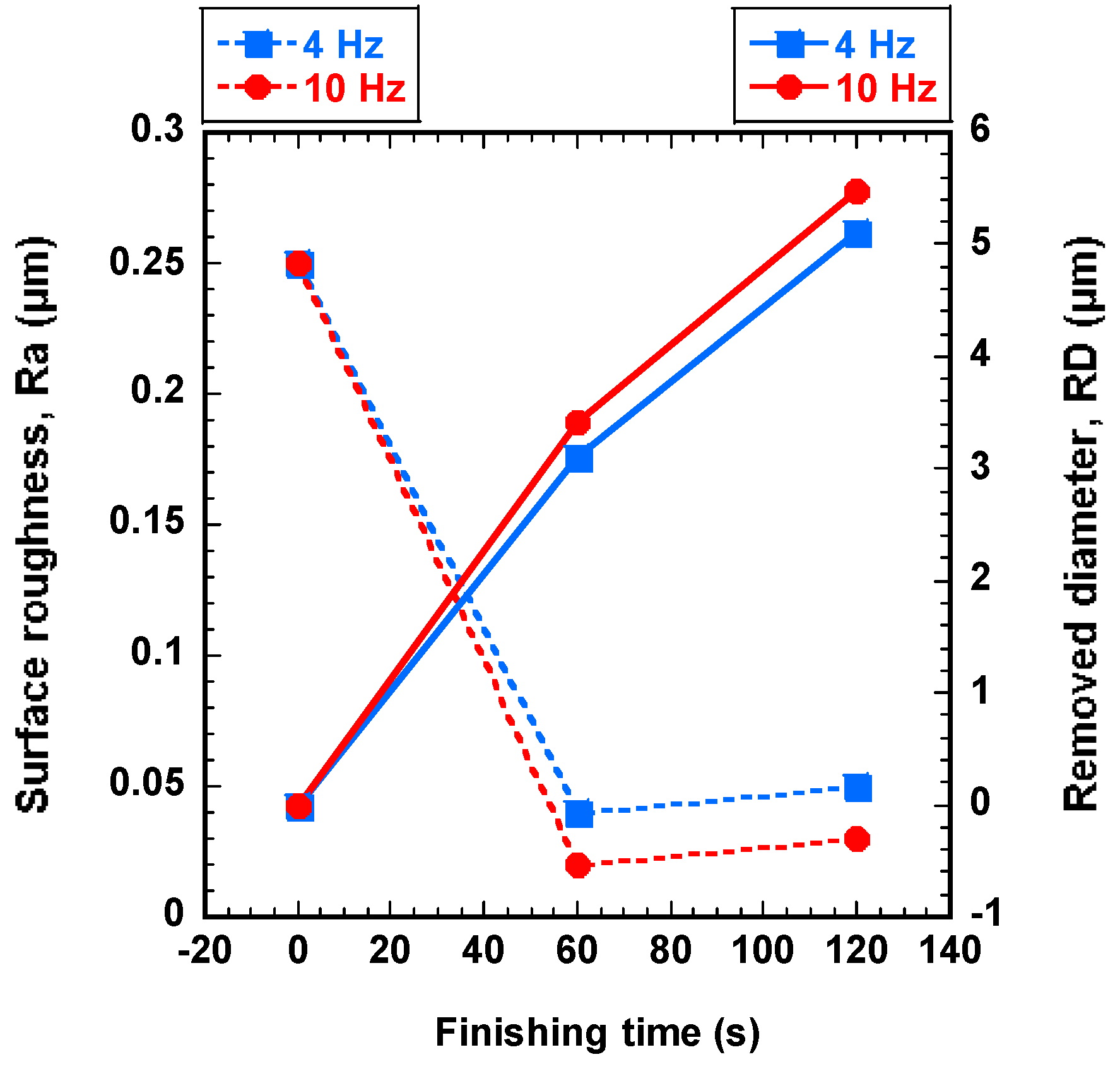

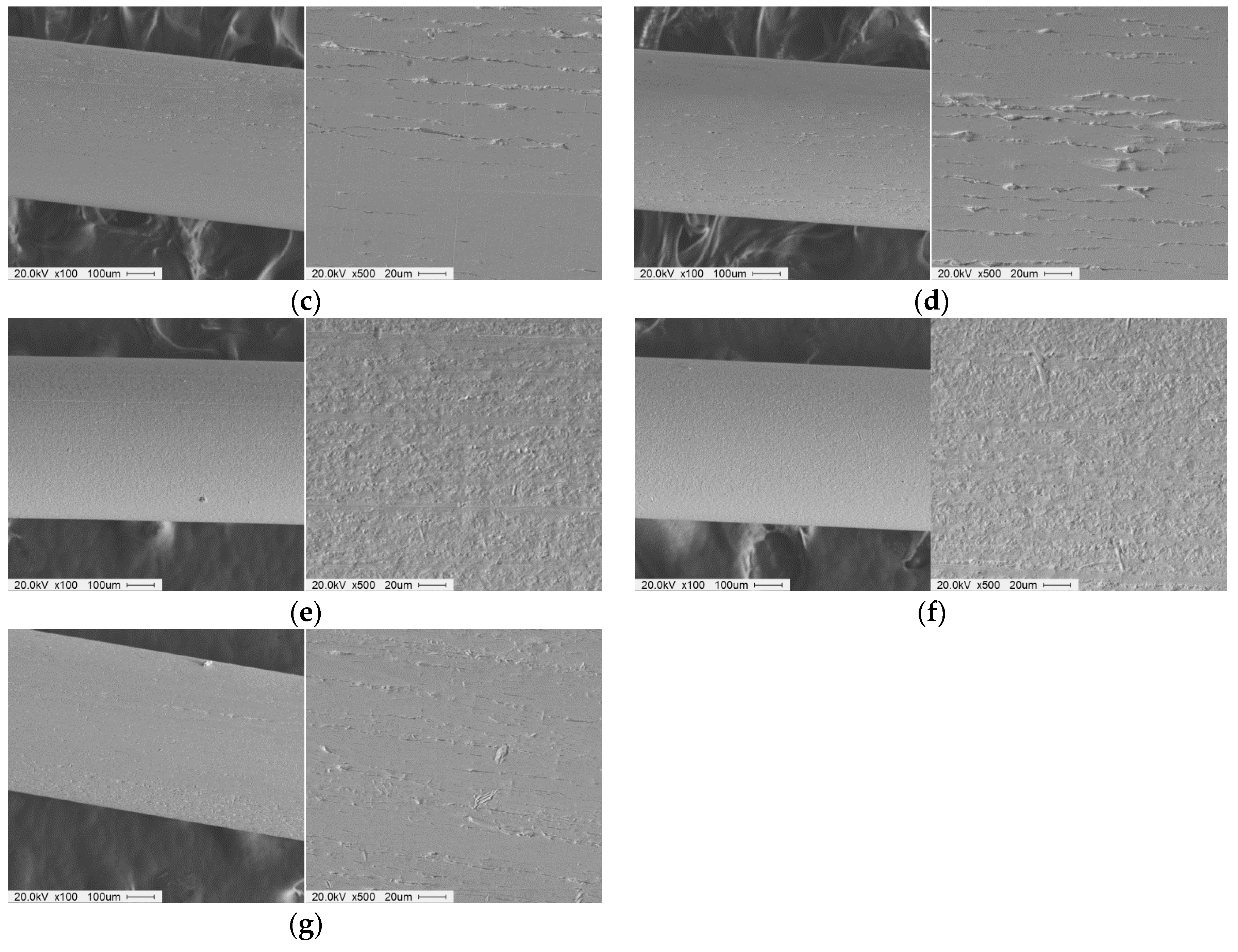
| Tensile Strength | Yield Strength | Hardness | Elasticity | Fatigue Resistance |
|---|---|---|---|---|
| 2709 MPa | 537 MPa | 58–63 HRc | 190–210 GPa | 107 cycles |
| Iron | Carbon | Manganese | Phosphorus | Sulfur |
|---|---|---|---|---|
| 97.98–98.41% | 0.8–0.93% | 0.7–1.0% | 0.04% max | 0.05% max |
| Input Parameter | Value Standard Units |
|---|---|
| Wire workpiece | AISI 1085 steel wire (Size: Ø 0.6 mm × (L) 280 mm) |
| Rotational speed of rotating magnetic field | 350, 600, 800 rpm |
| Electrolytic iron particle | 0.8 g (200 μm mean diameter) |
| Diamond abrasive particle (PCD) | 0.3 g (0.5, 3, 6 µm mean diameter) |
| Grinding oil | 200 µL (light oil) |
| Magnetic pole geometry |  |
| Magnetic flux densityin finishing zone | 460 mT |
| Vibration frequency of wire workpiece | 4, 10 Hz, and Amplitude: 2 mm |
| Finishing time | 0 s, 60 s, 120 s |
© 2019 by the authors. Licensee MDPI, Basel, Switzerland. This article is an open access article distributed under the terms and conditions of the Creative Commons Attribution (CC BY) license (http://creativecommons.org/licenses/by/4.0/).
Share and Cite
Heng, L.; Yin, C.; Han, S.H.; Song, J.H.; Mun, S.D. Development of a New Ultra-High-Precision Magnetic Abrasive Finishing for Wire Material Using a Rotating Magnetic Field. Materials 2019, 12, 312. https://doi.org/10.3390/ma12020312
Heng L, Yin C, Han SH, Song JH, Mun SD. Development of a New Ultra-High-Precision Magnetic Abrasive Finishing for Wire Material Using a Rotating Magnetic Field. Materials. 2019; 12(2):312. https://doi.org/10.3390/ma12020312
Chicago/Turabian StyleHeng, Lida, Cheng Yin, Seok Ho Han, Jun Hee Song, and Sang Don Mun. 2019. "Development of a New Ultra-High-Precision Magnetic Abrasive Finishing for Wire Material Using a Rotating Magnetic Field" Materials 12, no. 2: 312. https://doi.org/10.3390/ma12020312





